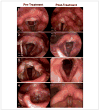Factors Associated With Infectious Laryngitis: A Retrospective Review of 15 Cases
- PMID: 28397557
- PMCID: PMC5460979
- DOI: 10.1177/0003489417694911
Factors Associated With Infectious Laryngitis: A Retrospective Review of 15 Cases
Abstract
Objectives: To identify the culturable microbes associated with infectious laryngitis and outline effective treatment strategies.
Methods: This is a retrospective chart review of adult patients with persistent dysphonia plus evidence of laryngeal inflammation who underwent biopsy for culture at a tertiary care medical center. Demographic factors, symptoms as reported on validated patient assessment tools, past medical history, social history, culture results, and treatment duration and response were reviewed.
Results: Fifteen patients with infectious laryngitis were included in this study. Culture results demonstrated Methicillin-sensitive Staphylococcus aureus (MSSA), Methicillin-resistant Staphylococcus aureus (MRSA), Pseudomonas aeruginosa, Serratia marcescens, and "normal respiratory flora." In most patients, multiple courses of prolonged antibiotics were needed to treat MSSA or MRSA. Infections associated with other microbes resolved with a single course of antibiotics.
Conclusions: In this population, infectious laryngitis is defined as colonization with bacteria not found in the previously characterized laryngeal microbiome of benign vocal fold lesions. In suspected cases of infectious laryngitis, culture is recommended, by biopsy if needed. For MSSA- and MRSA-associated laryngitis, an extended course of antibiotics may be necessary for symptom improvement and resolution of laryngeal inflammation. However, the optimal treatment regimen has yet to be defined and will require larger, prospective studies.
Keywords: Staphylococcus aureus; bacteria; chronic laryngitis; infectious laryngitis; inflammation; laryngitis.
Conflict of interest statement
The author(s) declared no potential conflicts of interest with respect to the research, authorship, and/or publication of this article.
Figures



Similar articles
-
Methicillin-resistant and methicillin-sensitive Staphylococcus aureus laryngitis.Laryngoscope. 2012 Nov;122(11):2497-502. doi: 10.1002/lary.23537. Epub 2012 Sep 10. Laryngoscope. 2012. PMID: 22965913
-
MRSA chronic bacterial laryngitis: A growing problem.Laryngoscope. 2018 Apr;128(4):921-925. doi: 10.1002/lary.26955. Epub 2017 Oct 31. Laryngoscope. 2018. PMID: 29086424
-
Infectious granulomatous laryngitis: a retrospective study of 24 cases.Eur Arch Otorhinolaryngol. 2008 Jun;265(6):675-80. doi: 10.1007/s00405-007-0533-4. Eur Arch Otorhinolaryngol. 2008. PMID: 18060554
-
Methicillin-resistant Staphylococcus aureus laryngitis: a report of two cases with different clinical presentations.ORL J Otorhinolaryngol Relat Spec. 2012;74(3):146-8. doi: 10.1159/000337160. Epub 2012 Apr 5. ORL J Otorhinolaryngol Relat Spec. 2012. PMID: 22488250 Review.
-
Isolated Aspergillus Laryngitis: Spectrum, Management, and Review of Literature.J Voice. 2022 Nov;36(6):880.e13-880.e19. doi: 10.1016/j.jvoice.2020.09.009. Epub 2020 Sep 29. J Voice. 2022. PMID: 33004228 Review.
Cited by
-
Chronic Bacterial Laryngitis: A Diagnostic Pitfall for Clinicians.Intern Med. 2022 Feb 15;61(4):597-598. doi: 10.2169/internalmedicine.7796-21. Epub 2021 Sep 18. Intern Med. 2022. PMID: 34544943 Free PMC article. No abstract available.
-
Use of a transnasal flexible laryngoscope tip for laryngeal culturing: A novel in-office technique.Laryngoscope Investig Otolaryngol. 2021 Dec 7;7(1):197-201. doi: 10.1002/lio2.712. eCollection 2022 Feb. Laryngoscope Investig Otolaryngol. 2021. PMID: 35155798 Free PMC article.
-
[Prolonged ulcerative laryngitis].HNO. 2022 Jan;70(1):14-18. doi: 10.1007/s00106-021-01079-0. Epub 2021 Jun 25. HNO. 2022. PMID: 34170335 Free PMC article. Review. German.
-
Pseudomonas laryngeal perichondritis: unexpected diagnosis.BMJ Case Rep. 2020 Dec 22;13(12):e237129. doi: 10.1136/bcr-2020-237129. BMJ Case Rep. 2020. PMID: 33370978 Free PMC article.
-
Glottic Staphylococcus aureus in a patient with systemic lupus erythematosus: videolaryngostroboscopic characteristics.BMJ Case Rep. 2022 Feb 28;15(2):e245840. doi: 10.1136/bcr-2021-245840. BMJ Case Rep. 2022. PMID: 35228218 Free PMC article.
References
-
- Stein DJ, Noordzij JP. Incidence of chronic laryngitis. Ann Otol Rhinol Laryngol. 2013;122:771–774. - PubMed
-
- Dworkin JP. Laryngitis: types, causes, and treatments. Otolaryngol Clin North Am. 2008;41:419–436. ix. - PubMed
-
- Turan M, Ekin S, Ucler R, et al. Effect of inhaled steroids on laryngeal microflora. Acta Otolaryngol. 2016;136:699–702. - PubMed
-
- Schwartz SR, Cohen SM, Dailey SH, et al. Clinical practice guideline: hoarseness (dysphonia) Otolaryngol Head Neck Surg. 2009;141:S1–S31. - PubMed
MeSH terms
Substances
Grants and funding
LinkOut - more resources
Full Text Sources
Other Literature Sources
Medical
Miscellaneous

